 W
WClematis is a genus of about 300 species within the buttercup family, Ranunculaceae. Their garden hybrids have been popular among gardeners, beginning with Clematis × jackmanii, a garden standby since 1862; more hybrid cultivars are being produced constantly. They are mainly of Chinese and Japanese origin. Most species are known as clematis in English, while some are also known as traveller's joy, a name invented for the sole British native, C. vitalba, by the herbalist John Gerard; virgin's bower for C. terniflora, C. virginiana, and C. viticella; old man's beard, applied to several with prominent seedheads; leather flower for those with fleshy petals; or vase vine for the North American Clematis viorna.
 W
WOld man's beard is an invasive plant in New Zealand that affects indigenous biodiversity. It is declared an unwanted organism under the Biosecurity Act 1993 which means it cannot be sold, distributed or propagated.
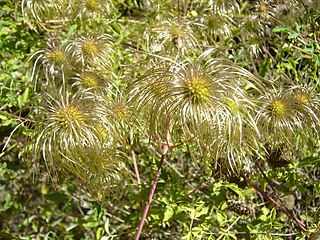 W
WClematis akebioides is a plant that originates in Western China. It is a flowering plant that comes in many different colors. It is mainly greenish yellow in color. It contains certain chemical constituents that are widely used in western medicine. The plant is a photoautotroph, meaning it transforms light energy received from the sun into chemical energy through photosynthesis. This species is unique from others from its genus in that it emits a sweet smell. The species usually grows in shrub lands where it uses its stems to provide support for other plants.
 W
WClematis alpina, the Alpine clematis, is a flowering deciduous vine of the genus Clematis. Like many members of that genus, it is prized by gardeners for its showy flowers. It bears 1 to 3-inch spring flowers on long stalks in a wide variety of colors. C. alpina is native to Europe; in the United States it grows best in American Horticultural Society zones 9 to 6, which are generally found in the southern USA.
 W
WClematis aristata, known as Australian clematis, wild clematis, goat's beard or old man's beard, is a climbing shrub of the family Ranunculaceae, found in eastern Australia in dry and wet forests of Queensland, New South Wales, Victoria and Tasmania. In spring to early summer it produces mass displays of attractive star-shaped flowers usually borne in short panicles with each flower up to 70 mm diameter and possessing four narrow white or cream tepals. Fertile male and female reproductive structures occur in flowers of separate plants (dioecy) making this species an obligate outcrosser with pollen movement among plants most likely facilitated by insects. Each seed head on female plants consists of multiple achenes with each seed bearing a plumose awn 2–4.5 cm long promoting dispersal by wind.
 W
WClematis armandii is a flowering climbing plant of the genus Clematis. Like many members of that genus, it is prized by gardeners for its showy flowers. It is native to much of China and northern Burma.
 W
WClematis brachiata, commonly known as traveller's joy, is a hardy, deciduous Southern African liana of the family Ranunculaceae.
 W
WClematis chrysocoma, the gold wool clematis, is a flowering vine of the genus Clematis. It has showy flowers like many members of that genus, but it also has a yellow down covering its young branches, leaves, and flower stalks. It is endemic to southern China.
 W
WClematis cirrhosa is a species of flowering plants in the family Ranunculaceae. It includes the 'Freckles', 'Wisley Cream' and 'Jingle Bells' cultivars.
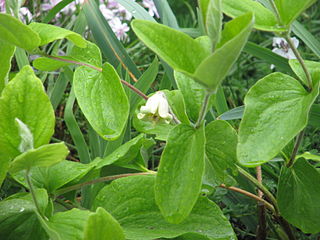 W
WClematis coactilis, common name Virginia white-hair leather flower, is a plant species endemic to the western part of the US State of Virginia. It is reported from only Botetourt, Roanoke, Craig, Montgomery, Giles, Wythe, and Pulaski Counties. It is usually found on soils formed from shale, less often dolomite, limestone or sandstone.
 W
WClematis crispa is a species of flowering plant in the buttercup family known by the common name swamp leatherflower. It is found in southeastern United States.
 W
WClematis cunninghamii is one of seven species of clematis that is native to New Zealand. C. cunninghamii is regularly found throughout the North Island.
 W
WDelphinine is a toxic diterpenoid alkaloid found in plants from the Delphinium (larkspur) and Atragene genera, both in the family Ranunculaceae. Delphinine is the principal alkaloid found in Delphinium staphisagria seeds – at one time, under the name stavesacre, a very well known herbal treatment for body lice. It is related in structure and has similar effects to aconitine, acting as an allosteric modulator of voltage gated sodium channels, and producing low blood pressure, slowed heart rate and abnormal heart rhythms. These effects make it highly poisonous, but in very small doses it has some uses in herbal medicine.
 W
WClematis drummondii is a species of flowering plant in the buttercup family, Ranunculaceae, that is native to the Southwestern United States and northern Mexico. Common names include old man's beard, Texas virgin's bower, and barba de chivato. It is a white-flowered vine that can be found clambering among other wildflowers, on shrubs and on fence rows. The natural habitat of C. drummondii includes the Chihuahuan and Sonoran deserts as well as prairies and grasslands. The sap of this plant is caustic, although its foliage, stems, and roots can be used for dye if caution is used while handling and if breathing the fumes is avoided.
 W
WClematis flammula is a temperate liana known by the common name fragrant virgin's bower. It is native to southern Europe and northern Africa, but it is cultivated worldwide as an ornamental plant in gardens. The woody vine bears fragrant white flowers and small green achenes. When the flowers are newly opened they have a strong sweet almond fragrance.
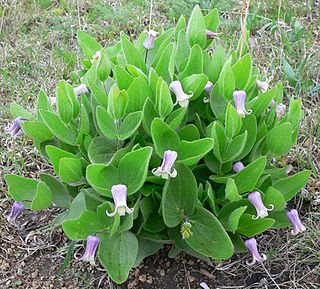 W
WClematis fremontii is a species of flowering plant in the buttercup family known as Fremont's leather flower. It is endemic to the United States where it is known from several disjunct populations throughout the central and southeastern states. Previously unknown populations were discovered in the mid-2000s in Tennessee and Georgia. Other names for this plant include Fremont's crowsfoot, Fremont's leather-plant, leatherplant, and rattleweed.
 W
WClematis gouriana, or Indian Traveller's Joy, is a liana found in Asia which belongs to the buttercup family (Ranunculaceae). It was described by Roxb. ex DC. and published in Regni Vegetabilis Systema Naturale 1: 138-139, in 1818.
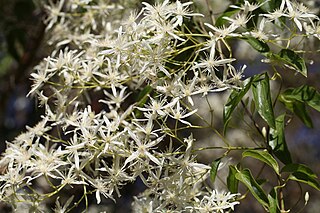 W
WClematis glycinoides, commonly known as headache vine, is a climbing shrub of the family Ranunculaceae, found in eastern Australia, and New Caledonia.
 W
WClematis hedysarifolia is a liana, endemic to peninsular India, belonging to the buttercup family (Ranunculaceae). It was described by Augustin Pyramus de Candolle and published in Regni Vegetabilis Systema Naturale 1: 148, in 1817.
 W
WClematis heracleifolia, the tube clematis, is a species of flowering plant in the buttercup family Ranunculaceae, native to central and northern China. Unlike most other members of the genus Clematis, it has a scrambling rather than a climbing habit.
 W
WClematis hirsutissima is a species of flowering plant in the buttercup family known by the common name hairy clematis. It is native to much of the western United States, from Washington to Nebraska. It is a small, erect plant which, unlike other Clematis, does not generally produce vines. It is quite variable in appearance, especially across varieties. In general the hairy stem reaches up to about half a meter tall and has many hairy leaves divided into lance-shaped lobes. The inflorescence appears at the tip of the stem and bears a solitary flower. The flower is made up of an urn-shaped cup of deep purple-blue petallike sepals, which are fuzzy and have pointed or rounded tips. Rare individuals have white or pinkish sepals. There are no true petals. The fruit is a hairy achene with a very long beak and a plume on the end.
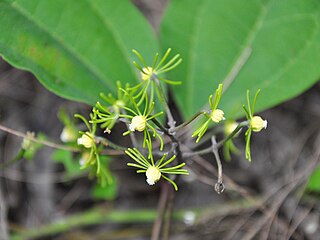 W
WClematis horripilata is a species of vine in the family Ranunculaceae. Its inflorescence contains several light greenish yellow flowers. This plant can be found in South Asia and Southeast Asia. It has been known by the synonym Naravelia laurifolia.
 W
WClematis integrifolia is a flowering vine of the genus Clematis. Like many members of that genus, it is prized by gardeners for its showy flowers. C. integrifolia bears nodding, urn-shaped blue flowers in summer that are 1.5 inches wide. It is a fairly short variety, growing only to 3 feet high. It is native to Europe and Asia; in the USA it grows best in American Horticultural Society zones 8 to 1.
 W
WClematis 'Jackmanii' is a Clematis cultivar which, when it was introduced in 1862, was the first of the modern large-flowered hybrid clematises of gardens. It is a climber with large violet-purple blooms, still among the most familiar climbers seen in gardens. It was produced from crosses made by the prominent nurseryman George Jackman (1837–1887), of Jackman & Sons, Woking, Surrey.
 W
WClematis lanuginosa is a flowering vine of the genus Clematis. Like many members of that genus, its hybrids are prized by gardeners for their showy flowers. It is endemic to Zhejiang province in eastern China and was first discovered near Ningbo by the plant hunter Robert Fortune in 1850 who sent plants back to England. It was lost to cultivation at about the time of the first world war and thought to be extinct but was rediscovered growing in the same area in 2008.
 W
WClematis lasiantha, the pipestem clematis, is a creamy-white flowering liana vine, belonging to subgenus Clematis of the large genus Clematis.
 W
WClematis ligusticifolia is a climbing, spreading vine with showy flowers. It is also known as Old-man's Beard and Yerba de Chiva, and Virgin's bower,. It is native to North America where it is widespread across the western United States in streamside thickets, wooded hillsides, and coniferous forests up to 8,500 feet.
 W
WOver 70 species and cultivars of clematis currently (2016) possess the Royal Horticultural Society's Award of Garden Merit, reflecting this plant's continued popularity in gardens in the United Kingdom. Clematis is a genus of woody based perennials, mostly climbers with a twining habit, though some are grown as groundcover or as herbaceous plants. They can be evergreen or deciduous. They bear flowers in all shades except black, pure blue, pure red and orange. The flowers are often large and showy. They can be single or double, fragrant or unscented, compact or vigorous, in a wide range of shapes and sizes. The flowering period varies from early spring to late summer. Many spring-flowering cultivars produce a second flush of blooms after the main display has finished, and many have attractive silky seed-heads prolonging the period of interest. Clematis can be grown against walls, fences, over pergolas and obelisks, or through other shrubs and trees.
 W
WClematis macropetala is a species of Clematis native to northwestern China, Mongolia, and adjoining areas of Siberia. Its cultivars 'Ballet Skirt', 'Lagoon', 'Pauline', and 'Wesselton' have gained the Royal Horticultural Society's Award of Garden Merit.
 W
WClematis marmoraria is an evergreen plant with parsley-like, leathery and dark green foliage. The white flowers are about 2 cm wide, blooming in early spring.
 W
WClematis microphylla is one of 8 Clematis species native to Australia. It occurs in all states and the ACT, but not in the Northern Territory.
 W
WClematis montana is a flowering plant in the buttercup family Ranunculaceae. A vigorous deciduous climber, in late spring it is covered with a mass of small blooms for a period of about four weeks. The flowers are white or pink, four-petalled, with prominent yellow anthers. It is native to mountain areas of Asia from Afghanistan to Taiwan.
 W
WClematis morefieldii is a rare species of flowering plant in the buttercup family known by the common names Morefield's leather flower and Huntsville vasevine.
 W
WClematis napaulensis is a species of flowering plant in the buttercup family, Ranunculaceae, native to China and the Indian subcontinent. The nodding cream-coloured flowers are up to 3 cm (1.2 in) across and scented. They are followed by handsome large fruit clusters. The plant will not survive harsh winter climates.
 W
WClematis occidentalis is a species of flowering plant in the buttercup family known by the common name western blue virginsbower. It is native to much of southern Canada and the northern United States. There are three varieties: var. occidentalis is limited to the eastern half of the species' range, var. grosseserrata to the western half, and var. dissecta is endemic to Washington. The plant varies somewhat in appearance. Generally they produce vines and climb on surfaces. The leaves are divided into three thick, green leaflets, which may have lobes or teeth. The flower has no petals, but petallike sepals which are usually either deep purple-blue in western populations or reddish purple in eastern plants. White flowers are rare.
 W
WClematis ochroleuca is a species of flowering plants in the buttercup family, Ranunculaceae, known by the common names curlyheads and erect silky leather-flower. It is native to North America with a distribution on the east coast of the United States from Long Island to northern Georgia.
 W
WClematis orientalis is a deciduous vine or scrambling shrub in the buttercup family Ranunculaceae, that originates from Asia and Central Europe. It was brought to the United States as an ornamental plant but escaped cultivation leading to its classification as a noxious weed in some states. Common names for C. orientalis include Chinese clematis, Oriental virginsbower, orange peel, and orange peel clematis.
 W
WClematis paniculata is a species of flowering plant in the buttercup family Ranunculaceae. It is one of seven species of clematis native to New Zealand. C. paniculata is the most common of these, and is widespread in forest throughout the country.
 W
WClematis pauciflora is a species of clematis known by the common name ropevine. This flowering plant is native to the high desert and chaparral slopes of southern California and Baja California. It is a woody vine with nodes every few centimeters which produce leaves and flowers. The leaves are made up of several dark green lobed leaflets, each one to three centimeters wide. From each leaf-bearing node grows an inflorescence of one to three flowers with narrow petallike sepals in shades of light yellow. Most of the flower is made up of a spray of up to 50 stamens and almost as many similar-looking pistils. The fruit is an achene equipped with a long plume-like style. The specific epithet pauciflora is Latin for 'few-flowered'.
 W
WClematis pitcheri is a species of flowering plant in the buttercup family known by the common name bluebill. It is found in the south-central United States.
 W
WClematis pubescens, known locally as common clematis, is a climbing shrub of the family Ranunculaceae with white blooms, found in coastal regions of southern Western Australia.
 W
WClematis recta, the erect clematis or ground virginsbower, is a species of Clematis unusual in that it is a free-standing shrub rather than a climbing plant. Growing usually on the margins of woodland areas, it is native to Eastern, Southern and Central Europe.
 W
WClematis rehderiana is a species of Clematis native to Nepal and China. It has gained the Royal Horticultural Society's Award of Garden Merit.
 W
WClematis socialis is a rare species of flowering plant in the buttercup family known by the common name Alabama leather flower. It is native to the US states of Alabama and Georgia, where it is known from only five populations. The species is seriously threatened by habitat destruction. It is a federally listed endangered species.
 W
WClematis terniflora is a plant in the buttercup family, Ranunculaceae. It is native to northeastern Asia. It was introduced into the United States in the late 1800s as an ornamental garden plant, and has naturalized in many of the eastern states. It is considered a Category II invasive plant in Florida and some other eastern states, meaning invading native plant communities but not yet seen as displacing native species.
 W
WClematis texensis, commonly called scarlet leather flower, is a climbing vine in the buttercup family (Ranunculaceae). It is native to the United States, where it is endemic to the Edwards Plateau of Texas. Its natural habitat is on rocky limestone cliffs and streamsides.
 W
WClematis versicolor is a species of flowering plant in the Buttercup family. It is a twining vine native to the Southeastern United States and Ozark Mountains. In this range it is found in scattered calcareous regions, where it is found on limestone outcrops, in thickets, and dry woods. It flowers in the summer.
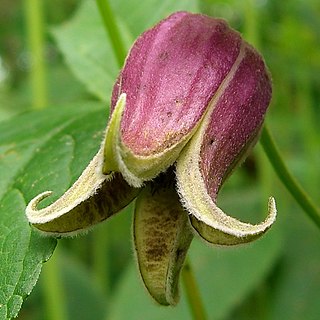 W
WClematis viorna, commonly known as vasevine or leatherflower, is a flowering vine native to the southeastern United States. It grows in wooded habitats and bears purple flowers in spring and summer.
 W
WClematis virginiana is a vine of the Ranunculaceae native to North America from Newfoundland to southern Manitoba down to the Gulf of Mexico. The rationale for some of the common names is unclear, as they include examples normally applied to unrelated plants, including twining parasites. The name "Love Vine" also is applied to alleged aphrodisiacs, such as Caribbean species of Cassytha, which are unrelated to Clematis, not being in the family Ranunculaceae.
 W
WClematis vitalba is a shrub of the family Ranunculaceae.
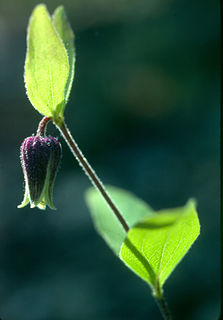 W
WClematis viticaulis is a species of flowering plant in the buttercup family known by the common names Millboro leatherflower and grape clematis.
 W
WClematis viticella, the Italian leather flower, purple clematis, or "Virgin's bower", is a species of flowering plant in the buttercup family; it is native to Europe. The climber was the first clematis imported into English gardens, where it was already being grown in 1569 by Hugh Morgan, apothecary to Elizabeth I. By 1597, when it was already being called "Virgin's Bower", there were two varieties in English gardens, a blue and a red.
 W
WClematis zeylanica is a species of liana belonging to the family Ranunculaceae which is native to Asia. It was earlier classified as Naravelia zeylanica, but was renamed when molecular phylogenetic research revealed that the genus was nested in Clematis.